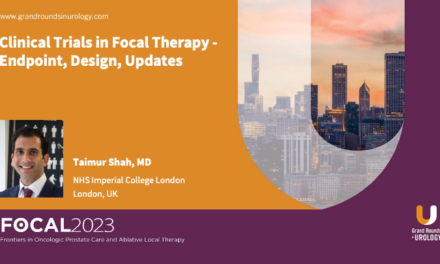Samir S. Taneja, MD, presented “Rationale for Focal Therapy” during the 2022 Frontiers in Oncologic Prostate Care and Ablative Local Therapy symposium on September 23, 2022, in Los Angeles, California.
How to cite: Taneja, Samir S. “Rationale for Focal Therapy.” September 23, 2022. Accessed Nov 2025. https://grandroundsinurology.com/rationale-for-focal-therapy/
Rationale for Focal Therapy – Summary
Samir S. Taneja, MD, James M. Neissa and Janet Riha Neissa Professor of Urologic Oncology in the Department of Urology at NYU Grossman School of Medicine and Vice Chair of Urology and Director of Urologic Oncology at NYU Langone Health, describes the basis for focal therapy, including how to successfully implement patient selection. He begins by outlining critical concepts physicians must accept when using focal therapy: It is a disease management strategy; the goal is prevention of metastasis and mortality; and there is a high likelihood of residual cancer. Dr. Taneja then breaks down the role of focal therapy in conventional treatment paradigms, underscoring that it is beneficial in favorable, unfavorable, and high-risk disease presentations. For example, in low-risk patients, focal therapy can slow clinical progression and delay active treatment. It can also be employed in multimodal interventions for high-risk cancer. He reviews the benefits and risks of using focal therapy in varying disease states and notes that follow-up after focal therapy can be difficult. Dr. Taneja then defines the necessary components of successful focal therapy, including attention to the margins, selecting the correct ablative energy source, and rigorous monitoring for recurrence. He concludes that the rationale for focal therapy is strong, as it is a lower-risk treatment with regard to quality of life, there is potential for durable local control, and re-treatment with limited toxicity is possible.
The annual symposium on Frontiers in Oncologic Prostate Care and Ablative Local Therapy (FOCAL) is an outstanding program on prostate imaging, transperineal interventions, and ablative treatments for prostate cancer and benign prostatic hyperplasia. Bringing together community-based, academic, and industry partners, FOCAL offers lectures by world-renowned faculty and hands-on training workshops on in-office transperineal interventions, fusion-guided prostate ablation and state-of-the-art BPH management with novel technologies. For more educational activities from the symposium that took place from September 23-24, 2022 in Los Angeles, California, visit our collection page.
ABOUT THE AUTHOR
Samir S. Taneja, MD, a surgeon whose long career has been spent in driving innovation in urologic cancer diagnosis and treatment, especially prostate cancer, has been selected to lead Northwell Health’s urology service line. Dr. Taneja has been appointed the senior vice president and chair of urology at Northwell Health and the chair of the Smith Institute for Urology. Previous to his position at Northwell Health, Dr. Taneja spent 29 years at NYU Langone Health, most recently serving as vice chair of the Department of Urology, director of the Division of Urologic Oncology, and a professor of urology and radiology at the medical school, as well as professor of bioengineering at the NYU Tandon School of Engineering.
The work that Dr. Taneja conducted at NYU Langone and its Perlmutter Cancer Center and Smilow Comprehensive Prostate Cancer Center has transformed the field of prostate cancer diagnosis and treatment by improving methods of prostate imaging, cancer detection, and disease localization. Dr. Taneja strives to integrate new technologies into his practice to evolve the practice of oncology. This has allowed him to care for prostate cancer patients individually by avoiding surgery or radiation when not needed, and using new targeted approaches to treat the disease when possible.
Dr. Taneja’s clinical research focuses on the use of imaging to detect and treat prostate cancer. He pioneered the use of MRI to diagnose and pinpoint prostate cancer, and in MRI-guided focal ablative therapies that aim to destroy the only cancerous portion of the prostate. Dr. Taneja has authored more than 200 articles, 30 book chapters, and 6 textbooks and monographs on urologic cancer and surgery. In addition, he is the editor of Taneja’s Complications of Urologic Surgery: Prevention and Diagnosis, one of the most widely read textbooks in American urology.





